NCERT Exemplar Solutions for Class 10 Maths Chapter 7 Co-Ordinate Geometry
- Introduction: Co-ordinate geometry is the branch of mathematics in which geometry is studied algebraically, i.e., In which geometrical figures (as points, lines etc.) are studied using equations.
- Rene Descartes (1596-1665), a French mathematician was the first who introduced the Co-ordinate Geometry or Analytical Geometry or Cartesian Geometry.
- In class IX, we have studied how to locate the position of a point on a plane. Now, we will study to find the distance between two points, the section formula and the area of a triangle.
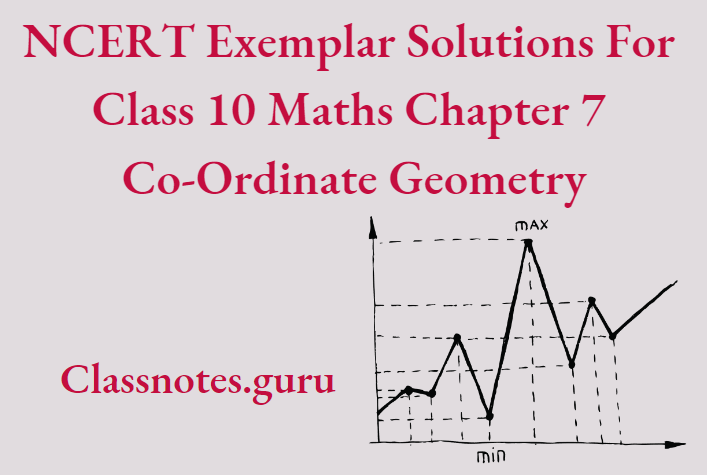
Distance Between Two Points
Let X’OX and Y’OY be coordinate axes. P and Q are two points in this cartesian plane with coordinates (X1, Y1) and (X2, Y2) respectively.

PL and QM are perpendiculars from P and Q respectively to the X-axis. PN is perpendicular from P to QM.
Now, O L =x1, P L=y1
O M =x2, Q M=y1
Coordinate Geometry Class 10 Important Questions with Solutions
Read and Learn More Class 10 Maths Solutions Exemplar
P N =L M
=O M-O L=x2-x1
P N=L M
and Q N =Q M-M N=Q M-P L
=y2 – y1
⇒ \(\triangle P Q N\) is a right-angled triangle.
⇒ \(P Q^2=P N^2+Q N^2\)
⇒ \(P Q^2=\left(x_2-x_1\right)^2+\left(y_2-y_1\right)^2\)
⇒ \(P Q=\sqrt{\left(x_2-x_1\right)^2+\left(y_2-y_1\right)^2}\)
Distance Between Origin And Point \(x_1, y_1\)
Distance between origin and point \(\left(x_1, y_1\right)=\sqrt{\left(x_1-0\right)^2+\left(y_1-0\right)^2}=\sqrt{x_1^2+y_1^2}\)
Condition Of Collinear Points On The Basis Of Distance
If the sum of any two distances is equal to the third distance, then the three points will be collinear.
NCERT Exemplar Solutions for Class 10 Maths Chapter 7 Co-Ordinate Geometry Solved Examples
Example 1. Find the distance between the following points :
- (3, 4) and (5, 2)
- (0, 2) and (4, – 1)
- (a, 2a) and (- a, – 2a)
- (4, – 3) and (- 6, 5)
Solution.
(1) Distance between the points (3,4) and (5,2)
=\(\sqrt{\left(x_2-x_1\right)^2+\left(y_2-y_1\right)^2}=\sqrt{(5-3)^2+(2-4)^2}\)
=\(\sqrt{4+4}=\sqrt{8}=2 \sqrt{2}\) units
(2) Distance between the points (0,2) and (4,-1)
=\(\sqrt{\left(x_2-x_1\right)^2+\left(y_2-y_1\right)^2}=\sqrt{(4-0)^2+(-1-2)^2}\)
=\(\sqrt{(4)^2+(-3)^2}=\sqrt{16+9}=\sqrt{25}\)=5 units
(3) Distance between the points (n, 2a) and (-r,-2 a)
=\(\sqrt{\left(x_2-x_1\right)^2+\left(y_2-y_1\right)^2}=\sqrt{(-a-a)^2+(-2 a-2 a)^2}\)
=\(\sqrt{(-2 a)^2+(-4 a)^2}=\sqrt{4 a^2+16 a^2}=\sqrt{20 a^2}=2 \sqrt{5} a \)units
(4) Distance between the points (4,-3) and (-6,5)
=\(\sqrt{\left(x_2-x_1\right)^2+\left(y_2-y_1\right)^2}=\sqrt{(-6-4)^2+(5+3)^2}\)
=\(\sqrt{(-10)^2+(8)^2}=\sqrt{100+64}=\sqrt{164}=2 \sqrt{41}\)units
Example 2. Find the distance between the points (5, 8) and (- 3, 2).
Solution:
Distance between the points (5, 8) and (- 3, 2).
=\(\sqrt{\left(x_2-x_1\right)^2+\left(y_2-y_1\right)^2}=\sqrt{(-3-5)^2+(2-8)^2}\)
=\(\sqrt{(-8)^2+(-6)^2}=\sqrt{64+36}=\sqrt{100}\)=10 units
The distance between the points =10 units
Example 3. Find the distance of the point (a cos \(\theta\), a sin \(\theta\)) from the origin.
Solution:
Distance between the points {a cos \(\theta\), a sin θ) and origin (0, 0)
= \(\sqrt{(a \cos \theta-0)^2+(a \sin \theta-0)^2}\)
= \(\sqrt{a^2 \cos ^2 \theta+a^2 \sin ^2 \theta}=\sqrt{a^2\left(\cos ^2 \theta+\sin ^2 \theta\right)}\)
= \(\sqrt{a^2} (\cos ^2 \theta+\sin ^2 \theta=1)\)
= a units
The distance of the point = a units
Example 4. Find the distance of the point (3, 4) from the origin.
Solution:
Distance of the point (3, 4) to the origin
= \(\sqrt{(3-0)^2+(4-0)^2}=\sqrt{9+16}=\sqrt{25}\)=5 units
The distance of the point (3, 4) from the origin=5 units
Example 5. If the distance between the points (x, 2) and (6, 5) is 5 units, find the value of x.
Solution:
Distance between the points (x, 2) and (6, 5)
=\(\sqrt{(6-x)^2+(5-2)^2}=\sqrt{x^2-12 x+36+9}=\sqrt{x^2-12 x+45}\)
Given that, \(\sqrt{x^2-12 x+45}\)=5
⇒ \(x^2-12 x+45=25\)
⇒ \(x^2-12 x+20=0\)
⇒ \(x^2-2 x-10 x+20=0\)
x(x-2)-10(x-2)=0
(x-2)(x-10)=0
x-2=0 or x-10=0
x = 2 or x = 10
The value of x 2 or 10
Example 6. If the distances of P(x,y) from A(5, 1) and B(-1,5) are equal, then prove that 3x = 2y.
Solution:
Since P(x,y) is equidistant from A(5, 1) and B(-1, 5).
PA = PB
⇒ \(\sqrt{(x-5)^2+(y-1)^2}=\sqrt{(x+1)^2+(y-5)^2}\) (by using distance formula)
Squaring both sides, we get
⇒ \((x-5)^2+(y-1)^2=(x+1)^2+(y-5)^2\)
⇒ \(x^2-10 x+25+y^2-2 y+1=x^2+2 x+1+y^2-10 y+25\)
-10 x-2 y+26=2 x-10 y+26
-10 x-2 x=-10 y+2 y
12 x=8 y
3 x = 2 y
Hence Proved.
Example 7. Prove that the points (5, -2), (-4, 3) and (10, 7) are the vertices of an isosceles right-angled triangle.
Solution:
Given
(5, -2), (-4, 3) and (10, 7)
Let the points are A (5, – 2), B (- 4, 3) and C (10, 7).
Therefore,\(A B^2=(-4-5)^2+(3+2)^2=(-9)^2+(5)^2=81+25=106\)
⇒ \(B C^2=(10+4)^2+(7-3)^2=(14)^2+(4)^2\)=196+16=212
\(A C^2=(10-5)^2+(7+2)^2=(5)^2+(9)^2\)=25+81=106
A B=A C=\(\sqrt{106}\)
and \(A B^2+A C^2=B C^2\)
⇒ \(\triangle A B C\) is an isosceles right-angled triangle.
Hence Proved.
Example 8. Prove that the points (a, a),(-a,-a) and \((-a \sqrt{3}, a \sqrt{3})\) are the vertices of an equilateral triangle.
Solution:
Given
(a, a),(-a,-a) and \((-a \sqrt{3}, a \sqrt{3})\)
Let the points are A(a, a), B(-a,-a) and \(C(-a \sqrt{3}, a \sqrt{3})\).
A B=\(\sqrt{(-a-a)^2+(-a-a)^2}=\sqrt{(-2 a)^2+(-2 a)^2}\)
= \(\sqrt{4 a^2+4 a^2}=\sqrt{8 a^2}=2 \sqrt{2} a\)
B C=\(\sqrt{(-a \sqrt{3}+a)^2+(a \sqrt{3}+a)^2}\)
=\(\sqrt{3 a^2+a^2-2 \sqrt{3} a^2+3 a^2+a^2+2 \sqrt{3} a^2}=\sqrt{8 a^2}=2 \sqrt{2} a\)
C A=\(\sqrt{(-a \sqrt{3}-a)^2+(a \sqrt{3}-a)^2}\)
=\(\sqrt{3 a^2+a^2+2 \sqrt{3} a^2+3 a^2+a^2-2 \sqrt{3} a^2}\)
=\(\sqrt{8 a^2}=2 \sqrt{2} a\)
A B =B C = C A
∴ \(\triangle A B C\) is an equilateral triangle.
Hence Proved.
Example 9. Prove that the points (2, – 1), (4, 1), (2, 3) and (0, 1) are the vertices of a square.
Solution:
Given
(2, – 1), (4, 1), (2, 3) and (0, 1)
Let the points are A(2, – 1), B(4, 1), C(2, 3) and D(0, 1).
⇒ \(A B^2 =(4-2)^2+(1+1)^2=4+4=8\)
A B =\(\sqrt{8}=2 \sqrt{2}\)
⇒ \(B C^2 =(2-4)^2+(3-1)^2=(-2)^2+(2)^2\)=4+4=8
B C =\(\sqrt{8}=2 \sqrt{2}\)
⇒ \(C D^2 =(0-2)^2+(1-3)^2=(-2)^2+(-2)^2\)=4+4=8
C D =\(\sqrt{8}=2 \sqrt{2}\)
⇒ \(D A^2 =(2-0)^2+(-1-1)^2=(2)^2+(-2)^2\)=4+4=8
D A =\(\sqrt{8}=2 \sqrt{2}\)
Co-ordinate Geometry
⇒ \(A C^2 =(2-2)^2+(3+1)^2\)=0+16=16
A C =\(\sqrt{16}=4\)
and \(B D^2 =(0-4)^2+(1-1)^2=16+0=16\)
B D =\(\sqrt{16}=4\)
Now, A B=B C=C D=D A and A C=B D
⇒ A B C D is a square.
Example 10. Show that the points A(- 3, 3), B(7, – 2) and C(l, 1) are collinear.
Solution:
Given
A(- 3, 3), B(7, – 2) and C(l, 1)
A B =\(\sqrt{(7+3)^2+(-2-3)^2}=\sqrt{(10)^2+(-5)^2}\)
=\(\sqrt{100+25}=\sqrt{125}=5 \sqrt{5}\)
B C =\(\sqrt{(1-7)^2+(1+2)^2}=\sqrt{(-6)^2+(3)^2}\)
= \(\sqrt{36+9}=\sqrt{45}=3 \sqrt{5}\)
and \(A C =\sqrt{(1+3)^2+(1-3)^2}=\sqrt{(4)^2+(-2)^2}\)
= \(\sqrt{16+4}=\sqrt{20}=2 \sqrt{5}\)
Now, A C+B C=2 \(\sqrt{5}+3 \sqrt{5}=5 \sqrt{5}=A B\)
Points A, B and C are collinear.
Example 11. Show that the points (9, – 2), (- 5, 12) and (- 7, 10) lie on that circle whose centre is the point (1,4).
Solution:
Given
(9, – 2), (- 5, 12) and (- 7, 10)
Let the given points are A (9, -2), B (-5, 12) and C (- 7, 10),
If point‘O’is (1, 4), then
O A =\(\sqrt{(1-9)^2+(4+2)^2}=\sqrt{(-8)^2+(6)^2}\)
=\(\sqrt{64+36}=\sqrt{100}=10\)
O B =\(\sqrt{(1+5)^2+(4-12)^2}=\sqrt{(6)^2+(-8)^2}\)
= \(\sqrt{36+64}=\sqrt{100}=10\)
O C =\(\sqrt{(1+7)^2+(4-10)^2}=\sqrt{(8)^2+(-6)^2}\)
= \(\sqrt{64+36}=\sqrt{100}=10\)
OA = OB = OC
Point ‘O’ is equidistant from the points A, B and C.
Point (1,4) is the centre of that circle at which the points (9, -2), (-5, 12) and (- 7, 10) lie.
Hence Proved.
Example 12. In the given figure, \(\triangle\)ABC is an equilateral triangle of side 3 units. Find the coordinates of the other two vertices.
Solution:
Given
In the given figure, \(\triangle\)ABC is an equilateral triangle of side 3 units.
Since B is at a distance of 3 units from A on the X-axis in the positive direction, so B will be 5 units away from the origin.
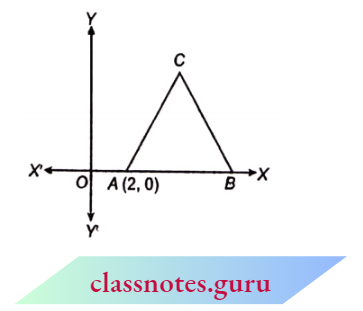
So, B = (5, 0)
Let M be the mid-point of AB
⇒ \(A M=\frac{1}{2} A B=\frac{3}{2}\) units
AC = 3 Units
In right \(\triangle C M A\), by Pythagoras theorem
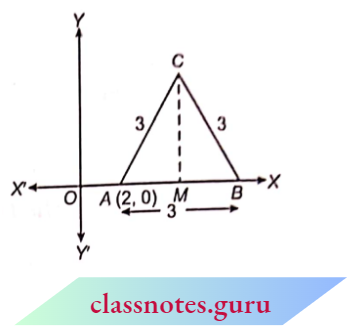
⇒ \(C M^2 =A C^2-\Lambda M^2\)
= \(9-\frac{9}{4}=\frac{27}{4}\)
⇒ \(C M =\sqrt{\frac{27}{4}}=\frac{3 \sqrt{3}}{2}\)
So, the coordinates of C are (O M, M C)
C=(O A+A M, M C) .
C=\(\left(2+\frac{3}{2}, \frac{3 \sqrt{3}}{2}\right)=\left(\frac{7}{2}, \frac{3 \sqrt{3}}{2}\right)\)
NCERT Exemplar Class 10 Maths Chapter 7 Solutions
Example 13. The coordinates of two vertices of an equilateral triangle are (0, 0) and (3,\(\sqrt{3}\)). Find the coordinates of the third vertex of the triangle.
Solution:
Given
The coordinates of two vertices of an equilateral triangle are (0, 0) and (3,\(\sqrt{3}\)).
Let the \(\triangle\) ABC be an equilateral triangle in which the coordinates of points B and C are (0, 0) and (3,3, \(\sqrt{3})\) respectively.
Let the coordinates of the third vertex A be (x,y).
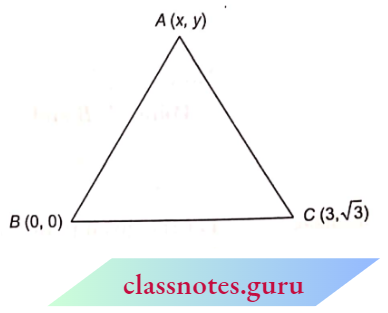
In equilateral \(\triangle\)ABC
A B=A C=B C
⇒ \(A B^2=A C^2=B C^2\)
⇒ \(A B^2=A C^2\)
⇒ \((x-0)^2+(y-0)^2=(x-3)^2+(y-\sqrt{3})^2 \quad B(0,0)\)
⇒ \(x^2+y^2=x^2-6 x+9+y^2-2 \sqrt{3} y+3\)
⇒ \(6 x+2 \sqrt{3} y=12 \quad \Rightarrow \quad 3 x+\sqrt{3} y=6 \)
⇒ \(\sqrt{3} x+y=2 \sqrt{3} \quad y=2 \sqrt{3}-\sqrt{3} x\)
and \(A B^2=B C^2\)
⇒ \((x-0)^2+(y-0)^2=(3-0)^2+(\sqrt{3}-0)^2\)
⇒ \(x^2+y^2=9+3\)
⇒ \(x^2+(2 \sqrt{3}-\sqrt{3} x)^2=12\)
⇒ \(x^2+12+3 x^2-12 x=12\)
∴ \(4 x^2-12 x\)=0
4 x(x-3)=0
x=0 or x-3=0
x=0 or x=3
Put these values in eq. (1)
x=0, then y=2\( \sqrt{3}-0=2 \sqrt{3}\)
x=3 , y=2\( \sqrt{3}-3 \sqrt{3}=-\sqrt{3}\)
Co-ordinates of third vertex =(0,2 \(\sqrt{3}\)) or (\(3,-\sqrt{3})\)
Example 14. What point on the X-axis is equidistant from (7, 6) and (-3, 4)?
Solution:
Given
(7, 6) and (-3, 4)
We know that the y-co-ordinate of a point on the X-axis is always 0. So, let a point on the X-axis be P(x, 0) and let two given points be A(7, 6) and B(-3, 4).
According to the condition,
P A=P B
⇒ \( \sqrt{(x-7)^2+(0-6)^2}=\sqrt{(x+3)^2+(0-4)^2}\)
Squaring both sides, we have
⇒ \(x^2-14 x+49+36 =x^2+6 x+9+16\)
Required point is (3,0) 20 x =60 \(\Rightarrow x=3\)
Example 15. Find the equation of the set of all points which are twice as far from (3, 2) as from (1, 1).
Solution:
Given
(3, 2) and (1, 1)
Let P(x,y) be a point and let A(3, 2) and B = (1, 1) be two other points on the plane, such that
P A=2 P B
⇒ \(\sqrt{(x-3)^2+(y-2)^2}=2 \sqrt{(x-1)^2+(y-1)^2}\)
Squaring both sides, we have
⇒ \(x^2-6 x+9+y^2-4 y+4=4\left(x^2-2 x+1+y^2-2 y+1\right)\)
∴ \(3 x^2+3 y^2-2 x-4 y-5=0\) Which is the required equation.
Example 16. If A(2, 2), B(-2, -2), C(-2\(\sqrt{3}\),2\(\sqrt{3}\)) and D(-4 – 2\(\sqrt{3}\),4 + 2\(\sqrt{3}\)) are the co-ordinates of 4 points. What can be said about these four points?
Solution:
Given
(2, 2), B(-2, -2), C(-2\(\sqrt{3}\),2\(\sqrt{3}\)) and D(-4 – 2\(\sqrt{3}\),4 + 2\(\sqrt{3}\)) are the co-ordinates of 4 points.
A B=\(\sqrt{(-2-2)^2+(-2-2)^2}=4 \sqrt{2}\) units .
B C=\(\sqrt{(-2+2 \sqrt{3})^2+(-2-2 \sqrt{3})^2}\)
=\(\sqrt{4+12-8 \sqrt{3}+4+12+8 \sqrt{3}}=4 \sqrt{2}\) units
C D=\(\sqrt{(-2 \sqrt{3}+4+2 \sqrt{3})^2+(2 \sqrt{3}-4-2 \sqrt{3})^2}\)
= \(\sqrt{16+16}=4 \sqrt{2}\) units
A C=\(\sqrt{(2+2 \sqrt{3})^2+(2-2 \sqrt{3})^2}\)
=\(\sqrt{4+12+8 \sqrt{3}+4+12-8 \sqrt{3}}=4 \sqrt{2}\) units
A D=\(\sqrt{(2+4+2 \sqrt{3})^2+(2-4-2 \sqrt{3})^2}\)
=\(\sqrt{36+12+24 \sqrt{3}+12+4+8 \sqrt{3}}=\sqrt{64+32 \sqrt{3}}\) units
B D=\(\sqrt{(-2+4+2 \sqrt{3})^2+(-2-4-2 \sqrt{3})^2}\)
=\(\sqrt{4+12+8 \sqrt{3}+36+12+24 \sqrt{3}}=\sqrt{64+32 \sqrt{3}}\) units
Here, AB = BC = CD = AC and also, AD = BD
So, in first view, it seems to be the vertices of a square.
(But),Here, AB, BC, CD and DA are not equal, (the order of A, B, C and D must be cyclic in the case of the square).
Also, AD and BD are equal but they cannot be diagonals. So, they do not form a square. Actually, A, B and D lie on a circle with C as the centre (as CA = CB = CD i.e., C is equidistant from A, B and D).
NCERT Exemplar Solutions for Class 10 Maths Chapter 7 Co-Ordinate Geometry – To Divide A Line Segment In a Given Ratio
Internal Division
The coordinates of a point which divides the line segment joining the points A(x1,y1) and B(x2,y2) in the ratio m: n internally are
⇒ \(\left(\frac{m x_2+n x_1}{m+n}, \frac{m y_2+n y_1}{m+n}\right)\)

Proof: Let X’OX and Y’OYare the coordinate axes and A (x1,y1) and B (x2,y2) be any two points in this cartesian plane. Let P(x,y) be any point on line segment AB which divides AB in the ratio m: n.
⇒ \(\frac{A P}{B P}=\frac{m}{n}\)
AL, PN and BM are perpendiculars from, P and B respectively on X-axis.
AH and PIC are perpendiculars from and P respectively to PN and BM.
Now, OL = x1, OM = x2, ON = x
AL = y1, BM = y2> PN =y
AH = LN = ON -OL=x-x
PH = PN – NH = PN – AL =y -y1
Pk = NM = OM – ON =x2-x
and BIC = BM – ICM = BM – PN =y2 -y
Here, \(\triangle\)AHP and \(\triangle\)PKB are similar.
⇒ \(\frac{A H}{P K}=\frac{P H}{B K} =\frac{A P}{P B}\)
⇒ \(\frac{x-x_1}{x_2-x}=\frac{y-y_1}{y_2-y}=\frac{m}{n}\)
⇒ \(\frac{x-x_1}{x_2-x} =\frac{m}{n}\) and \(\frac{y-y_1}{y_2-y}=\frac{m}{n}\)
⇒ \(\frac{x-x_1}{x_2-x} =\frac{m}{n} \quad \Rightarrow \quad n x-n x_1=m x_2-m x\)
⇒ \(m x+n x =m x_2+n x_1 \quad \Rightarrow \quad(m+n) x=m x_2+n x_1\)
x =\(\frac{m x_2+n x_1}{m+n}\)
Similarly,\(\frac{y-y_1}{y_2-y}=\frac{m}{n} \quad \Rightarrow \quad n y-n y_1=m y_2-m y\)
⇒ \(m y+n y=m y_2+n y_1 \quad \Rightarrow \quad(m+n) y=m y_2+n y_1\)
y=\(\frac{m y_2+n y_1}{m+n}\)
Therefore, the co-ordinates of point P=\(\left(\frac{m x_2+m x_1}{m+n}, \frac{m y_2+m y_1}{m+n}\right)\)
Co-ordinates of the Mid-point of a Line Segment
The co-ordinates of the mid-point of the line segment joining the points A(x1,y1) and (x2,y2) are \(\left(\frac{x_1+x_2}{2}, \frac{y_1+y_2}{2}\right)\)
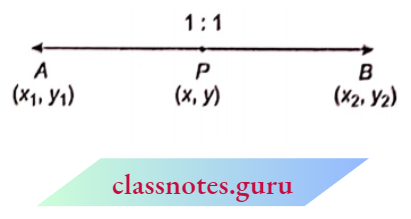
Proof: Let P (x, y) be the mid-point of the line joining the points A (x1,y1) and B (x2, y2)
Ap : PB = 1:1
x =\(\frac{1\left(x_2\right)+1\left(x_1\right)}{1+1}=\frac{x_1+x_2}{2}\)
y =\(\frac{1\left(y_2\right)+1\left(y_1\right)}{1+1}=\frac{y_1+y_2}{2}\)
Co-ordinates of point P =\(\left(\frac{x_1+x_2}{2}, \frac{y_1+y_2}{2}\right)\)
NCERT Exemplar Solutions for Class 10 Maths Chapter 7 Co-Ordinate Geometry – To Divide A Line Segment In a Given Ratio Solved Examples
Example 1. Find the coordinates of a point which divides the line segment joining the points (5, 1) and (-10, 11) in the ratio 2 : 3 internally.
Solution:
Given
(5, 1) and (-10, 11)
Let the coordinates of the required point he (x,y).
Here, \(\quad\left(x_1, y_1\right)=(5,1)\) and \(\left(x_2, y_2\right)=(-10,11)\)
and \(\left(x_1, y_1\right)\) =(5,1) and \(\quad\left(x_2, y_2\right)=(-10,11)\)
m: n = 2: 3
x =\(\frac{m x_2+n x_1}{m+n}=\frac{2(-10)+3(5)}{2+3}=\frac{-20+15}{5}=\frac{-5}{5}=-1\)
y =\(\frac{m y_2+n y_1}{m+n}=\frac{2(11)+3(1)}{2+3}=\frac{22+3}{5}=\frac{25}{5}=5\)
Co-ordinates of required point =(-1,5)
Example 2. Suppose point P lies on the line segment joining points A{-3, 4) and B(- 2, – 6) such that 2AP=3BP then, find the coordinates of point P.
Solution:
A{-3, 4) and B(- 2, – 6) such that 2AP=3BP
Given That, 2 AP = 3 BP
⇒ \(\frac{A P}{B P}=\frac{3}{2}\)
m : n = 3 : 2
(x1, y1) = (- 3, 4) and (x2,y2) = (-2,- 6)
Now, let the coordinates of point P are (x,y)
x=\(\frac{3(-2)+2(-3)}{3+2}=\frac{-12}{5}\)
and y=\(\frac{3(-6)+2(4)}{3+2}=-2\)
Co-ordinates of point P=\(\left(\frac{-12}{5},-2\right)\)
Example 3. Find the co-ordinates of the mid-point of the line segment joining the points A(3, -5) and B(1, 1 )
Solution:
Co-ordinates of the mid-point of AB = \((-1 + 3 5 + (-1)^ \left(\frac{3+1}{2}, \frac{-5+1}{2}\right)=(2,-2)\)
Example 4. The coordinates of the endpoints of a diameter are (-1, 5) and (3, -1). Find the coordinates of the centre and the radius of the circle.
Solution:
Given
The coordinates of the endpoints of a diameter are (-1, 5) and (3, -1).
Let the coordinates of the end points of diameter AB be A (-1, 5) and .8 (3, -1).
Co-ordinates of the centre P = Co-ordinates of mid-point of AB
= \(\left(\frac{-1+3}{2}, \frac{5+(-1)}{2}\right)=(1,2)\)
and radius of circle = length of P A
= \(\sqrt{(1+1)^2+(2-5)^2}=\sqrt{4+9}=\sqrt{13}\) units
Example 5. The coordinates of the mid-point of the line joining the points A and B are (2, -3). If the coordinates of point A are (-3, 4), then find the coordinates of point B.
Solution:
Given
The coordinates of the mid-point of the line joining the points A and B are (2, -3). If the coordinates of point A are (-3, 4),
Let the co-ordinates of point B=\(\left(x_2, y_2\right)\)
Given that,\(\frac{-3+x_2}{2}=2 \quad \Rightarrow \quad-3+x_2=4\)
⇒ \(x_2=7\) and \(\frac{4+y_2}{2}=-3\)
4+y_2=\(-6 \quad \Rightarrow \quad y_2=-10\)
Co-ordinates of point B=(7,-10)
Example 6. Find the ratio in which the X-axis divides the line segment joining the points (8, 5) and (-3,-7).
Solution:
Let the X-axis divide the join of points (8, 5) and (- 3, – 7) in the ratio k: 1.
We know that at X-axis
y = 0
⇒ \(\frac{k \cdot y_2+1 \cdot y_1}{k+1} =0\)
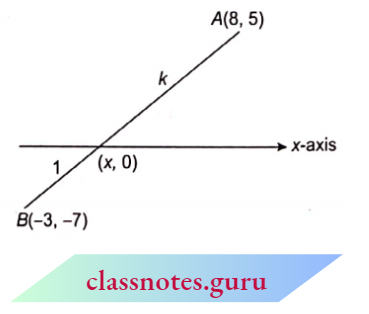
⇒ \(\frac{k(-7)+1(5)}{k+1}\) =0
-7 k+5 =0
k = \(\frac{5}{7}\)
Required ratio =5: 7
Class 10 Coordinate Geometry NCERT Exemplar Book Solutions
Example 7. In what ratio does the point \(\left(\frac{24}{11}, y\right)\) divide the line segment joining the points P(2,-2) and Q(3, 7)? Also, find the value of y.
Solution:
Let \(M\left(\frac{24}{11}, y\right)\) divide the line segment joining the points.
P(2,-2) and Q(3,7) in the ratio k: 1.
⇒ \(\frac{24}{11}=\frac{k(3)+1(2)}{k+1}\) (by using section formula)
⇒ \(11(3 k+2)=24(k+1) \quad \Rightarrow \quad 33 k+22=24 k+24\)
33 k-24 k=24-22 \(\quad \Rightarrow \quad 9 k=2\)
⇒ \(k=\frac{2}{9}\)
Required ratio =k: 1
i.e.,\(\frac{2}{9}: 1\)
i.e.,2: 9 internally.
Required ratio = 2:9
Example 8. The co-ordinates of the vertices of \(\triangle\)ABC are A(3, 2), B( 1, 4) and C(-1, 0). Find the length of the median drawn from point A.
Solution:
Given
The co-ordinates of the vertices of \(\triangle\)ABC are A(3, 2), B( 1, 4) and C(-1, 0).
Let AP be the median drawn from vertex A.
The midpoint of BC is P.

Now, the coordinates of P
=\(\left(\frac{1+(-1)}{2}, \frac{4+0}{2}\right)=(0,2)\)
A P =\(\sqrt{(3-0)^2+(2-2)^2}\)
=\(\sqrt{9+0}=3 units\)
Example 9. Find the coordinates of the points of trisection of the line joining the points (3, -2) and (-3, -4).
Solution:
Let P (a, b) and Q (c, d) trisect the line joining the points A(3, -2) and B(-3, -4).

Now, point P (a, b) divides the line AB in the ratio 1:2
a =\(\frac{1(-3)+2(3)}{1+2}=\frac{3}{3}=1\)
b =\(\frac{1(-4)+2(-2)}{1+2}=-\frac{8}{3}\)
Therefore, coordinates of point P=\(\left(1,-\frac{8}{3}\right)\)
Q(c, d) divides the line A B in the ratio 2: 1.
c=\(\frac{2(-3)+1(3)}{2+1}=-1\)
d=\(\frac{2(-4)+1(-2)}{2+1}=\frac{-10}{3}\)
Therefore, co-ordinates of Q=\(\left(-1, \frac{-10}{3}\right)\)
Co-ordinates of points of trisection of A B=\(\left(1, \frac{-8}{3}\right) and \left(-1, \frac{-10}{3}\right)\)
Example 10. If two adjacent vertices of a parallelogram are (3, 2) and (-1, 0) and telagona intersect at (2, -5), then find the coordinates of the other two vertices.
Solution:
Given
Two adjacent vertices of a parallelogram are (3, 2) and (-1, 0) and telagona intersect at (2, -5)
Let two adjacent vertices of a parallelogram be A = (3, 2) and B(-1,0).
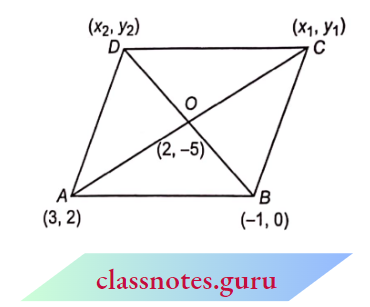
Let the coordinates of the other two vertices be C(X1, y1) and D(x2, y2)
We know that diagonals of a parallelogram bisect each other.
Mid-point of AC and the mid-point of BD are the same i.e., point O(2, -5).
⇒ \(\frac{3+x_1}{2}=2 and \frac{2+y_1}{2}\)=-5
⇒ \(x_1=1 and y_1=-12 \Rightarrow C \equiv\left(x_1, y_1\right) \equiv(1,-12)\)
Also, \(\frac{x_2-1}{2}=2 and \frac{y_2+0}{2}=-5\)
x2=5 and y2=-10 ⇒ D = (5,-10)
Hence, the remaining vertices are (1,-12) and (5,-10).
Example 11. The coordinates of three consecutive vertices of a parallelogram are (-1,0), (3, 1) and (2, 2). Find the coordinates of the fourth vertex of the parallelogram.
Solution:
Given
The coordinates of three consecutive vertices of a parallelogram are (-1,0), (3, 1) and (2, 2).
Let A(-1, 0), B (3, 1), C (2, 2) and D (x,y) be the vertices of a parallelogram ABCD.
We know that the diagonals of a parallelogram bisect each other.
Co-ordinates of the mid-point of AC = Co-ordinates of the mid-point of BD.
⇒ \(\left(\frac{-1+2}{2}, \frac{0+2}{2}\right)=\left(\frac{3+x}{2}, \frac{1+y}{2}\right)\)
⇒ \(\left(\frac{1}{2}, 1\right)=\left(\frac{3+x}{2}, \frac{1+y}{2}\right)\)
⇒ \(\frac{1}{2}=\frac{3+x}{2} and \quad 1=\frac{1+y}{2}\)
1=3+x and 2=1+y
x=-2 and y=1
Co-ordinates of fourth vertex =(-2,1)
Example 12. In which ratio the line y-x+2 = 0 Divides the line segment joining the points (3, -1) and (8,9)
Solution:
Let the ratio the line y-x+2 = 0 Divides the line segment joining the points (3, -1) and (8,9) in the ratio k: 1
Co-ordinates of P \(\equiv\left(\frac{8 k+3}{k+1}, \frac{9 k-1}{k+1}\right)\)

but this point P lies on the line y-x+2=0
⇒\(\frac{9 k-1}{k+1}-\frac{8 k+3}{k+1}+2\) =0
9 k-1-8 k-3+2 k+2 =0
3 k =2
k =\(\frac{2}{3}\)
Required ratio =\(\frac{2}{3}: 1=2: 3\)
Example 13. Find a point on the line through A{5, – 4) and B(-3, 2), that is, twice as far from A as from B.
Solution:
Given
A{5, – 4) and B(-3, 2)
Let P(x,y) be a point on AB such that
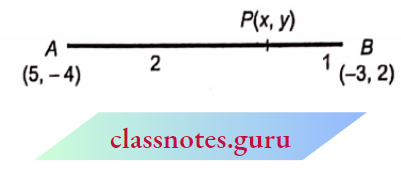
PA = 2PB
P A=2 P B
⇒ \(\frac{P A}{P B}=\frac{2}{1} \quad \Rightarrow \quad P A: P B=2: 1\)
So, by using the section formula for internal division,
x=\(\frac{m x_2+n x_1}{m+n}, y=\frac{m y_2+n y_1}{m+n}\)
x=\(\frac{2(-3)+1(5)}{2+1} \quad \Rightarrow \quad x=-\frac{1}{3}\)
and y=\(\frac{2(2)+1(-4)}{2+1} \Rightarrow \quad y=0\)
Required point =\(\left(-\frac{1}{3}, 0\right)\)
But, This is not the end of this question.
Think: Is it not possible that P(x, y) divides AB externally in the ratio 2: 1?
So, by using the section formula for external division,
x=\(\frac{2(-3)-1(5)}{2-1} \quad \Rightarrow x=-\frac{11}{1} \quad \Rightarrow \quad x=-11\)
and \( y=\frac{2(2)-1(-4)}{2-1} \Rightarrow y=\frac{8}{1} \quad \Rightarrow \quad y=8\)
So, the coordinates of p are (-11,8) also.
Hence, required points are \(\left(-\frac{1}{3}, 0\right)\) and (-11,8).
Example 14. Find the centroid of the triangle whose vertices are A(-1, 0), B{5, -2) and C(8, 2).
Solution:
Given
A(-1, 0), B{5, -2) and C(8, 2)
Centroid, the point where the medians of a triangle intersect, divides each median in the ratio 2: 1. Let AD be the median and G{x,y) be the centroid of \(\triangle\)ABC.
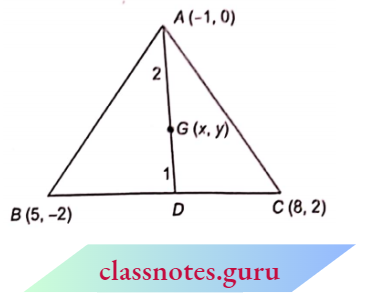
D is the mid-point of BC
D =\(\left(\frac{5+8}{2}, \frac{-2+2}{0}\right)\) (mid-point formula)
=\(\left(\frac{13}{2}, 0\right)\)
Now, G(x, y) divides the line segment joining A(-1,0) and \(D(\frac{13}{2}\), 0) internally in the ratio 2: 1.
So, by using section formula,
x=\(\frac{2\left(\frac{13}{2}\right)+1(-1)}{2+1} \quad \Rightarrow \quad x=4\)
y=\(\frac{2(0)+1(0)}{2+1} \quad \Rightarrow \quad y=0\)
and Centroid of \(\triangle A B C\)=(4,0)
Example 15. A line intersects the Y-axis and X-axis at points P and Q respectively. If (2, -5) is the mid-point of PQ, then find the coordinates of P and Q.
Solution:
Given
A line intersects the Y-axis and X-axis at points P and Q respectively. If (2, -5) is the mid-point of PQ
We know that at Y-axis, the x-coordinate is zero and at X-axis, y-coordinate is zero.
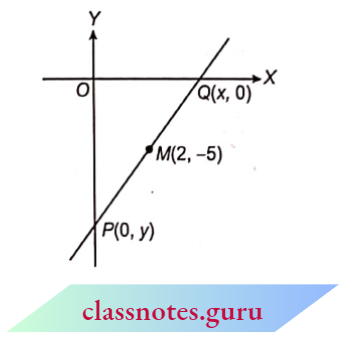
So, let P = (0,y)
and Q = (x, 0)
Since M(2, -5) is the mid-point of PQ.
By using the mid-point formula,
\(\frac{0+x}{2} =2, \quad \frac{y+0}{2}\)=-5
x =4, y=-10
P = (0,-10) and Q=(4,0)
Example 16. Point P(h, k) divides a line segment between the axes in the ratio 1: 2. Find the lengths (intercepts) on the axes made by this line segment. Also, find the area of the triangle formed by the line segment and the axes.
Solution:
Given
Point P(h, k) divides a line segment between the axes in the ratio 1: 2.
Let AB be the line segment joining A (0,y) and B(x, 0) between the axes.
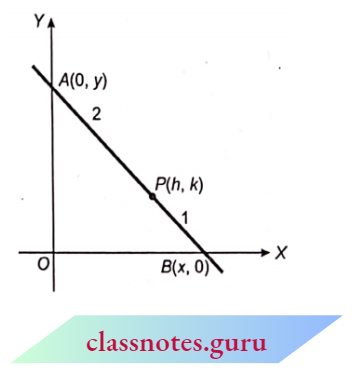
P(h, k) divides the line segment in the ratio 1: 2.
Now, question arises that whether PA : PB = 1 : 2 or PB : PA = 1:2
The answer is that we always take the former part of the ratio towards the X-axis and the latter part of the ratio towards the Y-axis.
So, here we will take PB: PA = 1: 2
By using the section formula,
h=\(\frac{1(0)+2(x)}{1+2} \Rightarrow h=\frac{2 x}{3} \quad \Rightarrow \quad x=\frac{3 h}{2}\)
and k=\(\frac{1(y)+2(0)}{1+2} \Rightarrow k=\frac{y}{3} \Rightarrow y\)=3 k
So, length of intercept on the X-axis =O B=x=\(\frac{3 h t}{2}\)
and the length of intercept on the Y-axis =O A=y=3 k.
Area of \(\triangle A O B=\frac{1}{2} \times O B \times O A=\frac{1}{2} \times \frac{3 h}{2} \times 3 k=\frac{9}{4}\) hk square units
Class 10 Coordinate Geometry Extra Questions
NCERT Exemplar Solutions for Class 10 Maths Chapter 7 Co-Ordinate Geometry -Area Of Triangle:
If the coordinates of the vertices of a triangle are [x1,y1), (x2,y2) and (x3,y3), then the area of a triangle (A) is given by
⇒ \(\Delta=\frac{1}{2}\left[x_1\left(y_2-y_3\right)+x_2\left(y_3-y_1\right)+x_3\left(y_1-y_2\right)\right]\)
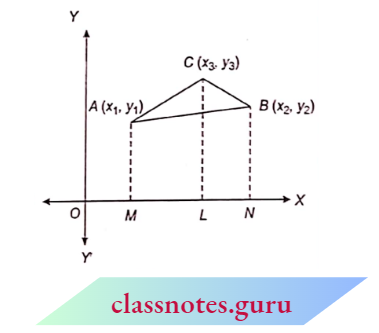
or \(\Delta=\frac{1}{2}\left[\left(x_1 y_2+x_2 y_3+x_3 y_1\right)-\left(x_2 y_1+x_3 y_2+x_1 y_3\right)\right]\)
Proof: Let X’OX and Y’OY be co-ordinate axes.
Let the co-ordinates of the vertices of \(\triangle\)ABC are A (x1,y1), B (x2,y2) and C (x3,y3). Draw the 1 perpendicular AM, BN and CL from A, B and C. Y-axis.
□ ALMLC, □ CLNB and □ AMNB are trapezium.
Now, the Area of AABC
= Area of □ AMLC + Area of □ CLNB – Area of □ AMNB
= \(\frac{1}{2}(A M+L C) \times M L+\frac{1}{2}(C L+B N) \times L N-\frac{1}{2}(A M+B N) \times M N\)
=\(\frac{1}{2}\left(y_1+y_3\right)\left(x_3-x_1\right)+\frac{1}{2}\left(y_3+y_2\right)\left(x_2-x_3\right)-\frac{1}{2}\left(y_1+y_2\right)\left(x_2-x_1\right)\)
= \(\frac{1}{2}\left[\left(y_1+y_3\right)\left(x_3-x_1\right)+\left(y_3+y_2\right)\left(x_2-x_3\right)-\left(y_1+y_2\right)\left(x_2-x_1\right)\right]\)
=\(\frac{1}{2}\left[y_1 x_3-y_1 x_1+y_3 x_3-y_3 x_1+y_3 x_2-y_3 x_3+y_2 x_2-y_2 x_3-y_1 x_2+y_1 x_1-y_2 x_2+y_2 x_1\right] \)
=\(\frac{1}{2}\left[x_1 y_2-x_1 y_3+x_2 y_3-x_2 y_1+x_3 y_1-x_3 y_2\right]\)
=\(\frac{1}{2}\left[x_1\left(y_2-y_3\right)+x_2\left(y_3-y_1\right)+x_3\left(y_1-y_2\right)\right]\)
=\(\frac{1}{2}\left[\left(x_1 y_2+x_2 y_3+x_3 y_1\right)-\left(x_2 y_1+x_3 y_2+x_1 y_3\right)\right]\)
If the area of a triangle is negative then we neglect the negative sign, because the area of a triangle is always positive.
If it is given that the area of a triangle is 10 then it will be taken ± 10 for calculations to evaluate the value (s) of unknown terms.
NCERT Exemplar Solutions for Class 10 Maths Chapter 7 Co-Ordinate Geometry – Collinear Points
Three points A (x1, y1 )B (x2,y2) and C (x3, y3) are collinear if Area of \(\triangle\)ABC = 0
Note: If the order of description of the boundary is anticlockwise, then the area is considered to be positive, but if the order of description is clockwise, then the area is considered to be negative.
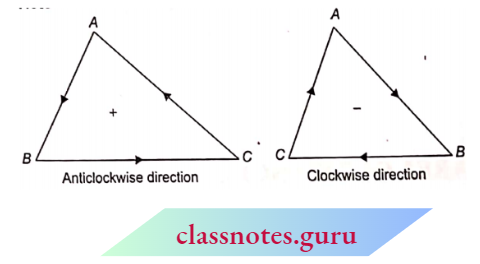
Remark: To move from A to 6 and then from B to C, we are moving in a clockwise direction. So the above area comes out to be negative.
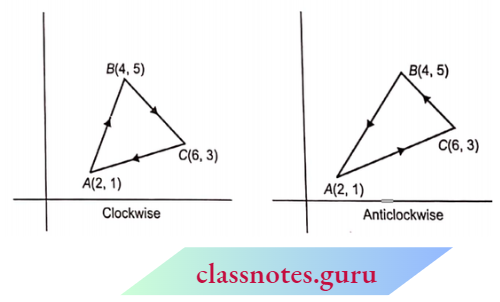
Now, if we take the points in an anticlockwise direction, as A(2,1), C(6,3) and B(4,5) then
area =\(\frac{1}{2}[2(3-5)+6(5-1)+4(1-3)]\)
= \(\frac{1}{2}(-4+24-8)\)=+6 square units.
NCERT Exemplar Solutions for Class 10 Maths Chapter 7 Co-Ordinate Geometry – Collinear Points Solved Examples
Example 1. Find the area of the triangle, whose vertices are (2,1), (4,5) and (6, 3).
Solution:
Given
Vertices are (2,1), (4,5) and (6, 3)
Area of triangle = \(\frac{1}{2}\left[x_1\left(y_2-y_3\right)+x_2\left(y_3-y_1\right)+x_3\left(y_1-y_2\right)\right]\)
= \(\frac{1}{2}[2(5-3)+4(3-1)+6(1-5)]=\frac{1}{2}(4+8-24)\)=-6
But the area of a triangle cannot be negative
Area of triangle = 6 square units
Example 2. Find the area of a triangle, whose vertices are (2, 3), (7, 5) and (-7, -5).
Solution:
Given
Vertices are (2, 3), (7, 5) and (-7, -5)
- Area of triangle = =\(\frac{1}{2}[x_1(y_2-y_3)+x_2(y_3-y_1)+x_3(y_1-y_2)\)]
- = \(\frac{1}{2}[2(5+5)+7(-5-3)-7(3-5)]=\frac{1}{2}(20-56+14)\)=-11
- But the area of a triangle cannot be negative
- Area of triangle = 11 square units
Example 3. Find the area of the triangle, whose vertices are (a, c +a), (a,c) and (-a, c, -b).
Solution:
Given
Vertices are (a, c +a), (a,c) and (-a, c, -b)
- Area of triangle =\(\frac{1}{2}\left[x_1\left(y_2-y_3\right)+x_2\left(y_3-y_1\right)+x_3\left(y_1-y_2\right)\right]\)
- = \(\frac{1}{2}[a(c-c+a)+a(c-a-c-a)-a(c+a-c)]\)
- = \(\frac{1}{n}\left[a^2-2 a^2-a^2\right]=-a^2\)
- But the area of a triangle cannot be negative
- Area of triangle = \(a^2\) square units
Example 4. Prove that the points (6, 4) (4, 5) and (2, 6) are collinear.
Solution:
Given
(6, 4) (4, 5) and (2, 6)
Area of triangle = \(\frac{1}{2}\left[x_1\left(y_2-y_3\right)+x_2\left(y_3-y_1\right)+x_3\left(y_1-y_2\right)\right]\)
⇒ \(\frac{1}{2}[6(5-6)+4(6-4)+2(4-5)]=\frac{1}{2}[-6+8-2]=0\)
Therefore, the given points are collinear.
Example 5. If the points A{x,y), B( 1, 4) and C(-2, 5) are collinear, then show that x + 3y = 13.
Solution:
Given points are collinear
Area of triangle = 0
⇒ \(\frac{1}{2}[x(4-5)+1(5-y)-2(y-4)]\) =0
-x+5-y-2 y+8 =0
x+3 y =13
Example 6. For what value of T, the points (k, 1), (1,-1) and (11,4) are collinear?
Solution:
The given points will be collinear if the area of the triangle = 0
⇒ \(\frac{1}{2}[k(-1-4)+1(4-1)+11(1+1)]\) =0
-5 k+3+22 =0
5 k =25
k =5
Example 7. If a \(\neq\) b \(\neq 0\), prove that the points \(\left(a, a^2\right),\left(b, b^2\right)\),(0,0) will not be collinear.
Solution:
Let the 3 points A=\(\left(a, a^2\right), B=\left(b, b^2\right)\) and C=(0,0) form a triangle ABC.
Area of triangle A B C = \(\frac{1}{2}\left|a\left(b^2-0\right)+b\left(0-a^2\right)+0\left(a^2-b^2\right)\right|\)
= \(\frac{1}{2}\left[a b^2-a^2 b\right]=\frac{1}{2} a b(b-a) \neq 0\)
Since a\((\triangle A B C) \neq 0\).
So, \(\triangle A B C\) will be formed.
Therefore 3 points A, B and C will not be collinear.
Hence Proved.
Example 8. If (x,y) is any point on the line segment joining the points (a, 0) and (0, b), then prove that \(\frac{x}{a}+\frac{y}{b}\)=1
Solution:
Given three points are collinear
Area of \(\triangle\)=0
⇒ \(\frac{1}{2}|x(0-b)+u(b-y)+0(y-0)|\)=0
-bx + ab – ay=0
Divide both sides by ab
–\(\frac{x}{a}+1-\frac{y}{b}=0 \quad \Rightarrow \quad \frac{x}{a}+\frac{y}{b}\)=1
Example 9. If P be a point equidistant from points A(3, 4) and B( 5, -2) and area \(\triangle\)PAB is 10 square units, then find the coordinates of point P.
Solution:
Let the coordinates of point P be (x,y).
Now, PA = PB
⇒ \(\sqrt{(x-3)^2+(y-4)^2}=\sqrt{(x-5)^2+(y+2)^2}\)
⇒ \(x^2+9-6 x+y^2+16-8 y=x^2+25-10 x+y^2+4+4 y^{\prime}\)
4 x-12 y=4
x-3 y=1 → Equation 1
and area of Δ=10
⇒ \(\frac{1}{2}[x(4+2)+3(-2-y)+5(y-4)]= \pm 10\)
⇒ \(6 r-6-3 y+5 y-20= \pm 20\)
6x + 2y – 26= \(\pm\) 20
6 x+2 y-26=20 or 6 x+2 y-26=-20
3 r+y=23 → Equation 2
or 3 r+y=3 → Equation 3
From eqs. (1) and (2) From eqs. (1) and (3)
x=7, y=2 , x=1, y=0
Required co-ordinates =(7,2) or (1,0)
Coordinate Geometry Chapter Class 10 Exemplar
Example 10. The area of a triangle is 5 sq. units. Two of its vertices are (2, 1) and (3, -2). If the third vertex is \(\left(\frac{7}{2}, y\right)\), find the value of y.
Solution :
Area of a \(\triangle A B C\)=5 sq units (given)

⇒ \(\frac{1}{2}\left|2(-2-y)+3(y-1)+\frac{7}{2}(1+2)\right|=5\)
⇒ \(\left|-4-2 y+3 y-3+\frac{21}{2}\right|=10\)
⇒ \(y+\frac{7}{2}= \pm 10\)
⇒ \(y+\frac{7}{2}=10\)
y=\(10-\frac{1}{7}\)or \(y=-10-\frac{1}{7}\)
y=\(\frac{13}{2}\) or y=\(-\frac{27}{2}\)
Hence, the value of y can be \(\frac{13}{2}\) and \(-\frac{27}{2}\).
NCERT Exemplar Solutions for Class 10 Maths Chapter 7 Co-Ordinate Geometry Miscellaneous Examples
Example 1. If the point P(k – 1, 2) is equidistant from the points A(3, K) and B(k, 5), find the values of k.
Solution:
Given that. P A=P B
⇒ \((k-1-3)^2+(2-k)^2=(k-1-k)^2+(2-5)^2\)
⇒ \((k-4)^2+(2-k)^2=(-1)^2+(-3)^2\)
⇒ \(k^2-8 k+16+4+k^2-4 k=1+9\)
⇒ \(2 k^2-12 k+10=0\)
⇒ \(k^2-6 k+5=0\)
⇒ \(k^2-5 k-k+5=0\)
⇒ \(k(k-5)-1(k-5)=0\)
(k-5)(k-1)=0
k-5=0 or k-1=0
k=5 or k=1
The values of k is 5 or 1.
Example 2. Find the point on X-axis which is equidistant from the points (5, -2) and (-3, 2).
Solution:
Let the required point on the X-axis be P(x, 0) and the given points be (5, -2) and B(—3, 2).
Now, given that
P A =P B
⇒ \(P A^2=P B^2\)
⇒ \((x-5)^2+(0+2)^2 =(x+3)^2+(0-2)^2\)
⇒ \(x^2-10 x+25+4 =x^2+6 x+9+4\)
-16 x =-\(16 \quad \Rightarrow x\)=1
The required point is (1, 0).
Example 3. Points and B(5, 7) lie on a circle uadi centre 0(2, -3y). Find the values of y. Hence, find the die radius of the die circle.
Solution:
Given
Points and B(5, 7) lie on a circle uadi centre 0(2, -3y).
Here, OA = OB (radii of a circle)
O A =O B
O A² =O B²
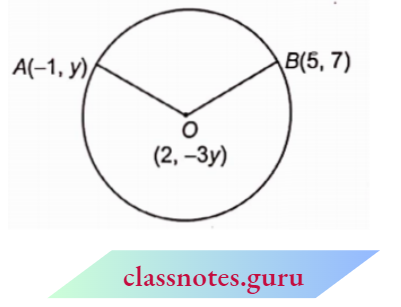
⇒ \((2+1)^2+(-3 y-y)^2=(2-5)^2+(-3 y-7)^2\)
⇒ \(9+16 y^2=9+9 y^2+42 y+49\)
⇒ \(7 y^2-42 y-49=0\)
⇒ \(y^2-6 y-7=0\)
⇒ \(y^2-7 y+y-7=0\)
⇒ y(y-7)+1(y-7)=0
⇒ y-7=0 or y+1=0
y=7 or y=-1
Now, the co-ordinates of centre O are either (2, -21) or (2, 3) when the centre is 0(2, -21), then radius = OB
= \(\sqrt{(2-5)^2+(-21-7)^2}\)
= \(\sqrt{9+784}=\sqrt{793}\) units
When centre is 0(2, 3), then
radius = OB
= \(\sqrt{(2-5)^2+(3-7)^2}\)
= \(\sqrt{9+16}=\sqrt{25}\)=5 units
The die radius of the die circle =5 units
Example 4. The points A(-1, 7), B{p, 3) and C(7, 3) are the vertices of a right triangle, right-angled at B. Find the value of p.
Solution:
Given
The points A(-1, 7), B{p, 3) and C(7, 3) are the vertices of a right triangle, right-angled at B.
In \(\triangle\)ABC
⇒ \(\angle\)B = 90°
⇒ \(A B^2+B C^2=A C^2\)
⇒ \((p-4)^2+(3-7)^2+(p-7)^2+(3-3)^2=(7-4)^2+(3-7)^2\)
⇒ \(p^2-8 p+16+p^2-14 p+49+0=9\)
⇒ \(2 p^2-22 p+56=0\)
⇒ \(p^2-11 p+28=0\)
⇒ \(p^2-7 p-4 p+28=0\)
⇒ \(p(p-7)-4(p-7)=0\)
⇒ \((p-7)(p-4)=0\)
p-7=0 or p-4=0
p=7 or p=4
when p=7, then the points B and C coincide and so no triangle is formed.
⇒ \(p \neq 7\)
Hence, p=4
Example 5. Find the coordinates of the point of trisection of the line segment joining the points A(-5, 6) and B(4, -3).
Solution:
Let P and Q be the points of trisection of AB, and then P divides AB in the ratio 1:2.
Co-ordinates of point P \(\equiv\left(\frac{-5 \times 2+4 \times 1}{1+2}, \frac{6 \times 2+1 \times-3}{1+2}\right) \equiv(-2,3)\) and point Q divides A B in the ratio 2: 1.
Co-ordinates of point Q=\(\left(\frac{-5 \times 1+4 \times 2}{2+1}, \frac{6 \times 1+2 \times-3}{1+2}\right)\)=(1,0)
The coordinates of the point of trisection are (-2,3) and (1,0).
Example 6. Find the ratio in which the point P(x, 2) divides the line segment joining the points. A(12, 5) and B(4, -3). Also, find the value of. v.
Solution:
Let point P(x, 2) divide AB in the ratio k: 1.
x=\(\frac{12 \times 1+k \times 4}{k+1}\) and 2=\(\frac{5 \times 1+k \times-3}{k+1}\)
Now, 2=\(\frac{5-3 k}{k+1}\)
2 k+2=\(-3 k+5 \quad \Rightarrow \quad 5 k=3\)
k=\(\frac{3}{5}\)
Required ratio =3: 5
and x=\(\frac{4 k+12}{k+1}=\frac{4 \times \frac{3}{5}+12}{\frac{3}{5}+1}=\frac{12+60}{3+5}=9\)
x=9
Example 7. Find The lengths of the medians AD and BE of \(\triangle\)ABC whose vertices are A( 7, 3),B(5, 3) and C(3, -1 ).
Solution:
Co-ordinates of mid-point D of BC
= \((\frac{3+5}{2}\), \(\frac{-1+3}{2})=(4,1)\)
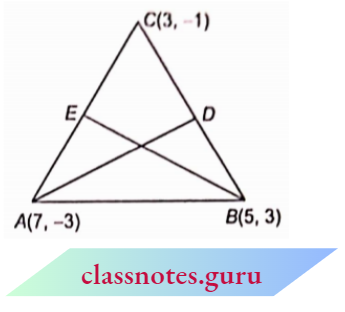
Ciomodinates of mid-point E of AC :
= \(\left(\frac{3+7}{2}, \frac{-1-3}{2}\right)=(5,-2)\)
A D=\(\sqrt{(7-4)^2+(-3-1)^2}=\sqrt{9+16}=\sqrt{25}\)=5 units
and \(B E=\sqrt{(5-5)^2+(3+2)^2}=\sqrt{0+25}=\sqrt{25}=5 units\)
Example 8. If the points A(-1, -4), B(b,c) and C(5, -1) are collinear and 2b + c = 4, find the values of b and c.
Solution:
Points A(- 1, -4), B(b, c) and C(5, -1) are collinear
area of \(\triangle\)ABC = 0
-1(c + 1)+ b(-1 -2 + 4) + 5(-4-c) = 0
– c – 1 + 3b – 20 -5c = 0
3b – 6c = 21
b -2c – 7 …(1)
Given that, 2b + c = 4 (2)
from eqs. (1) and (2), we get
b = 3 and c = -2
NCERT Exemplar Solutions for Class 10 Maths Chapter 7 Co-Ordinate Geometry Exercise 7.1
Question 1. Find the distance between the following pairs of points :
- (2, 3), (4,1)
- (-5, 7), (-1,3)
- (a, b), {-a, -b)
Solution :
(1) Distance between the points (2, 3) and (4, 1)
= \(\sqrt{\left(x_2-x_1\right)^2+\left(y_2-y_1\right)^2}\)
= \(\sqrt{(4-2)^2+(1-3)^2}\)
= \(\sqrt{(2)^2+(-2)^2}\)
= \(\sqrt{(4+4)}=\sqrt{8}=2 \sqrt{2}\) units
(2) Distance between the points (-5, 7) and (-1, 3)
= \(\sqrt{(-1+5)^2+(3-7)^2}\)
= \(\sqrt{(4)^2+(-4)^2}\)
= \(\sqrt{16+16}=\sqrt{32}=4 \sqrt{2}\) units
(3) Distance between the points (a, b) and {-a, -b).
= \(\sqrt{(-a-a)^2+(-b-b)^2}\)
= \(\sqrt{(-2 a)^2+(-2 b)^2}\)
= \(\sqrt{4 a^2+4 b^2}=\sqrt{4\left(a^2+b^2\right)}\)
=2 \(\sqrt{a^2+b^2}\) units
Question 2. Find the distance between the points (0, 0) and (36, 15). Can you now find the distance between the two towns A and B where town A is located 36 km east and 15 km north of town
Solution :
Distance between the points (0, 0) and (36, 15)
= \(\sqrt{(36-0)^2+(15-0)^2}\)
= \(\sqrt{1296+225}\)
=\(\sqrt{1521}\)=39 units
We can find the distance between two cities. The coordinates of the given cities in the cartesian coordinate system are A = (0,0) and B (36, 15).
The distance between these points is AB = 39 1cm.
Question 3. Determine if the points (1, 5), (2, 3) and (- 2, -11) are collinear.
Solution :
Let the given points are A(l, 5), B{2, 3) and C(-2,-ll).
A B =\(\sqrt{(2-1)^2+(3-5)^2}\)
=\(\sqrt{1+4}=\sqrt{5}\) units
B C =\(\sqrt{(-2-2)^2+(-11-3)^2}\)
=\(\sqrt{16+196}=\sqrt{212}\) units
C A =\(\sqrt{(-2-1)^2+(-11-5)^2}\)
=\(\sqrt{9+256}=\sqrt{265}\) units
Now, AB+B C \(\neq\) C A
Given points are not collinear.
Question 4. Check whether (5, -2), (6, 4) and (7, – 2) are the vertices of an isosceles triangle.
Solution :
Let the given points are A(5, -2), B{6, 4) and C(7, -2).
Now, A B =\(\sqrt{(6-5)^2+(4+2)^2}\)
=\(\sqrt{1+36}=\sqrt{37}\) units
B C =\(\sqrt{(7-6)^2+(-2-4)^2}\)
=\(\sqrt{1+36}=\sqrt{37}\) units
In a \(\triangle\)ABC,AB = BC
⇒ \(\triangle\)ABC is an isosceles triangle.
Therefore, the given points are the vertices of an isosceles triangle.
Question 5. In a classroom, 4 friends are seated at points A, B, C and D as shown in the figure. Champa and Chameli walk into the class and after observing for a few minutes Champa asks Chameli, “Don’t you think ABCD is a square?” Chameli disagrees. Using the distance formula, find which of them is correct

Solution :
In the figure, the coordinates of A, B, C and D are (3, 4), (6, 7), (9, 4) and (6, 1) respectively.
A B =\(\sqrt{(6-3)^2+(7-4)^2}\)
= \(\sqrt{9+9}=\sqrt{18}=3 \sqrt{2} units\)
B C =\(\sqrt{(9-6)^2+(4-7)^2}\)
=\(\sqrt{9+9}=\sqrt{18}=3 \sqrt{2}\)units
C D =\(\sqrt{(6-9)^2+(1-4)^2}\)
=\(\sqrt{9+9}=\sqrt{18}=3 \sqrt{2}\) units
D A =\(\sqrt{(3-6)^2+(4-1)^2}\)
=\(\sqrt{9+9}=\sqrt{18}=3 \sqrt{2}\) units
A C =\(\sqrt{(9-3)^2+(4-4)^2}\)
=\(\sqrt{36+0}=\sqrt{36}=6\)units
B D =\(\sqrt{(6-6)^2+(1-7)^2}\)
=\(\sqrt{0+36}=\sqrt{36}=6 units\)
Now, AB =BC = CD = DA and AC = BD
ABCD is a square.
So, Champa is correct.
Coordinate Geometry Class 10 Exemplar Questions and Answers
Question 6. Name the type of quadrilateral formed, if any, by the following points, and give reasons for your answer:
- (-1,-2). (1,0), (-1,2), (-3,0)
- (-3,5). (3, 1), (0,3), (-1,-4)
- (4, 5). (7. 6), (4, 3), (1,2)
Solution:
(1) Let points be A (-1, -2), (1,0), C (-1,2) and D (-3,0).
A B =\sqrt{(1+1)^2+(0+2)^2}
=\(\sqrt{4+4}=\sqrt{8}=2 \sqrt{2} units\)
B C =\(\sqrt{(-1-1)^2+(2-0)^2}\)
=\(\sqrt{4+4}=\sqrt{8}=2 \sqrt{2} units\)
C D =\(\sqrt{(-3+1)^2+(0-2)^2}\)
=\(\sqrt{4+4}=\sqrt{8}=2 \sqrt{2}\)units
D A =\(\sqrt{(-1+3)^2+(-2-0)^2}\)
=\(\sqrt{4+4}=\sqrt{8}=2 \sqrt{2}\) units
A C =\(\sqrt{(-1+1)^2+(2+2)^2}\)
=\(\sqrt{0+16}=\sqrt{16}\)=4 units
B D=\(\sqrt{(-3-1)^2+(0-0)^2}\)
=\(\sqrt{16+0}=\sqrt{16}\)=4 units
AB = BC = CD = DA and AC = BD
ABCD is a square.
Therefore, given points are the vertices of a square.
(2) Let given points are A(-3, 5), B(3, 1), C(0, 3) and D(-l, -4).
A B =\(\sqrt{(3+3)^2+(1-5)^2}\)
=\(\sqrt{36+16}=\sqrt{52}\)
=\(2 \sqrt{13}\)units
B C =\(\sqrt{(0-3)^2+(3-1)^2}\)
=\(\sqrt{9+4}=\sqrt{13} units\)
A C =\(\sqrt{(0+3)^2+(3-5)^2}\)
=\(\sqrt{9+4}=\sqrt{13}\) units
Now, BC + A C =\(\sqrt{13}+\sqrt{13}\)
=2 \(\sqrt{13}\)=A B
A, B and C are collinear.
Therefore, no quadrilateral will be formed from the given points.
(3) Let given points are A(4, 5), B(7, 6), C(4, 3) and D( 1,2).
A B=\(\sqrt{(7-4)^2+(6-5)^2}\)
=\(\sqrt{9+1}=\sqrt{10}\) units
B c =\(\sqrt{(4-7)^2+(3-6)^2}\)
=\(\sqrt{9+9}=\sqrt{18}=3 \sqrt{2}\) units
C D =\(\sqrt{(1-4)^2+(2-3)^2}\)
=\(\sqrt{9+1}=\sqrt{10}\) units
=\(\sqrt{(4-1)^2+(5-2)^2}\)
=\(\sqrt{9+9}=\sqrt{18}\)
=3 \(\sqrt{2}\) units
A C =\(\sqrt{(4-4)^2+(3-5)^2}\)
=\(\sqrt{0+4}=\sqrt{4}\)=2 units
B D =\(\sqrt{(1-7)^2+(2-6)^2}\)
=\(\sqrt{36+16}=\sqrt{52}\)
=2 \(\sqrt{13}units\)
AB = CD, AD = BC and AC \(\neq\) BD
ABCD is a parallelogram.
Therefore, given points are the vertices of a parallelogram.
Question 7. Find the point on the A-axis which is equidistant from (2, -5) and (-2, 9).
Solution :
Let any point of the A-axis be P(x, 0). The distance of this point from the points A(2, -5) and B(-2, 9) are equal.
PA = PB
P A^2 =P B^2
⇒ \((x-2)^2+(0+5)^2 =(x+2)^2+(0-9)^2\)
⇒ \(x^2-4 x+4+25 =x^2+4 x+4+81\)
⇒ \(x^2-4 x-x^2-4 x =4+81-4-25\)
-8x = 56
x = -7
Coordinates of required point = (-7, 0).
Question 8. Find the values of y for which the distance between the points P(2, – 3) and Q(10,jV is 10 units.
Solution :
According to the problem, PQ = 10
⇒ \(P^2=100 \)
⇒ \((10-2)^2+(y+3)^2=100\)
⇒ \(64+(y+3)^2=100\)
⇒ \((y+3)^2=100-64\)
⇒ \((v+3)^2=36\)
⇒ \((y+3)= \pm 6\)
y+3=6 or y+3=-6
y=3 or y=-9
Required values of y = 3, – 9
Question 9. If Q(0, 1) is equidistant from P(5, -3) and R(x, 6), find the values of .r. Also, find the distances QR and PR.
Solution :
Given that, Q is equidistant from P and R.
QP = QR
Q P = Q R
⇒ \(Q P^2=Q R^2\)
⇒ \((5-0)^2+(-3-1)^2=(x-0)^2+(6-1)^2\)
⇒ \(25+16=x^2+25\)
⇒ \(x^2=6 \Rightarrow x= \pm 4\)
⇒ \(Q R=\sqrt{( \pm 4-0)^2+(6-1)^2}\)
= \(\sqrt{16+25}=\sqrt{41}\) units
and P R =\(\sqrt{(5 \pm 4)^2+(-3-6)^2}\)
= \(\sqrt{(5+4)^2+81}\) or \(\sqrt{(5-4)^2+81}\)
= \(\sqrt{81+81}\) or \(\sqrt{1+81}\)
= \(\sqrt{162}\) or \(\sqrt{82}\)
P R =9 \(\sqrt{2} units\) or \(\sqrt{82} units\).
Question 10. Find a relation between x and; such that the point (x,y) is equidistant from the point (3, 6) and (- 3, 4).
Solution :
Given that, the distance of point {x,y) to (3, 6) = distance of point {x,y) to (-3, 4).
⇒ \(\sqrt{(x-3)^2+(y-6)^2}=\sqrt{(x+3)^2+(y-4)^2}\)
⇒ \((x-3)^2+(y-6)^2\)
= \((x+3)^2+(y-4)^2\)
⇒ \(x^2-6 x+9+y^2-12 y+36\)
=\(x^2+6 x+9+y^2-8 y+16\)
⇒ \(0=x^2+6 x+9+y^2-8 y+16-x^2 +6 x-9-y^2+12 y-36\)
12x- + 4y – 20 = 0
3x + y – 5 = 0
3x + y = 5
NCERT Exemplar Solutions for Class 10 Maths Chapter 7 Co-Ordinate Geometry Co-Ordinate Geometry Exercise 7.2
Question 1. Find the coordinates of the point which divides the join of (-1, 7) and (4, -3) in the ratio 2:3.
Solution:
Let A=(-1,7),B=(4,-3)
Let p(x, y) divide AB in the ratio 2: 3.
A(-1,7), P(x, y),B(4,-3)
⇒ \((x_1, y_1)=(-1,7),(x_2, y_2)=(4,-3)\)
and m: n=2: 3
Now, x=\(\frac{m x_2+m x_1}{m+n}\)
x=\(\frac{2 \times 4+3 \times(-1)}{2+3}=\frac{8-3}{5}=\frac{5}{5}\)=1
and y=\(\frac{m y_2+n y_1}{m+n}\)
y=\(\frac{2 \times(-3)+3 \times 7}{2+3}=\frac{-6+21}{5}=\frac{15}{5}\)=3
Coordinates of required point =(1,3).
Question 2. Find the coordinates of the points of trisection of the line segment joining (4,-1) and (-2,-3).
Solution :
Given (4,-1) and (-2,-3)
Let A = (4, – 1) and B = (-2, – 3).
Let P and Q trisect the line segment AB.
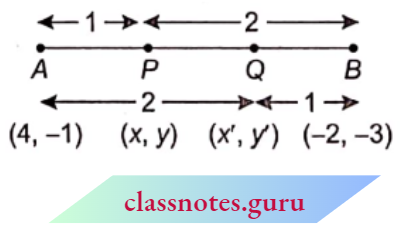
AP:PB= 1:2 and
AQ:QB = 2 : 1
For point P, x=\(\frac{m x_2+n x_1}{m+n}\)
x=\(\frac{1(-2)+2(4)}{1+2}=\frac{-2+8}{3}=\frac{6}{3}=2\)
and y=\(\frac{m r_2+n y_1}{m+n}\)
⇒ \(y=\frac{1(-3)+2(-1)}{1+2}=\frac{-3-2}{3}=\frac{-5}{3}\)
Coordinates of point P \(\equiv\left(2, \frac{-5}{3}\right)\)
For point Q, \(x^{\prime}=\frac{m_1 x_2+n_1 x_1}{m_1+n_1}\)
⇒ \(x^{\prime}=\frac{2(-2)+1(4)}{2+1}=\frac{-4+4}{3}=0\)
and \(y^{\prime}=\frac{m_1 y_2+n_1 y_1}{m_1+n_1}\)
⇒ \(y^{\prime}=\frac{2(-3)+1(-1)}{2+1}=\frac{-6-1}{3}=\frac{-7}{3}\)
Coordinates of point \(Q=\left(0, \frac{-7}{3}\right)\)
Coordinate Geometry Class 10 Chapter 7 Practice Questions
Question 3. To conduct Sports Day activities, in your rectangular-shaped school ground ABCD, lines have been drawn with chalk powder at a distance of lm each. 100 flower pots have been placed at a distance of lm from each other along AD, as shown in the figure. Niharika runs \(\frac{1}{4}\)th the distance AD on the 2nd line and posts a green flag.
Preet runs \(\frac{1}{5}\) through the distance AD on the eighth line and posts a red flag. What is the distance between both flags? If Rashmi has to post a blue flag exactly halfway between the line segment joining the two flags, where should she post her flag?
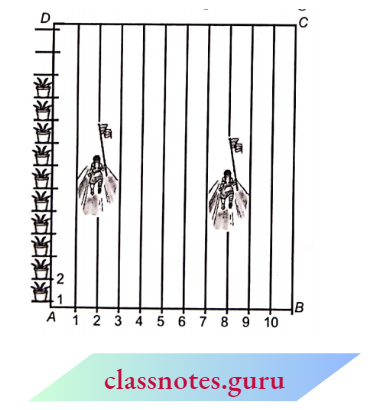
Solution :
100 flower pots are placed on side AD at a distance of 1 m from each other.
AD = 100 m
Position of Niharika’s flag = distance of \(\frac{1}{4}\)th part of AD in second row
⇒ \(\left(2,100 \times \frac{1}{4}\right)=(2,25)\)
Position of Preet’s flag = distance of \(\left(\frac{1}{5}\right)\) th part of AD in eighth row
= \(\left(8,100 \times \frac{1}{5}\right)=(8,20)\)
Distance between flags
= \(\sqrt{(8-2)^2+(20-25)^2}\)
= \(\sqrt{36+25}=\sqrt{61} \mathrm{~m}\)
Coordinates of the mid-point of (2,25) and (8,20)
= \(\left(\frac{2+8}{2}, \frac{25+20}{2}\right)=\left(5, \frac{45}{2}\right)\)
So, Rashmi should post her flag in the 5th row along AD at a distance of \(\frac{45}{2} \mathrm{~m}\).
Question 4. Find the ratio in which the line segment joining the points (-3, 10) and (6, – 8) is divided by (- 1, 6).
Solution :
Given
The line segment joining the points (-3, 10) and (6, – 8) is divided by (- 1, 6)
Let the points (-1, 6) divide the line segment joining the points (-3, 10) and (6, -8) in the ratio m: 1.
⇒ \(-1=\frac{m(6)+1(-3)}{m+1}\)
and \(6=\frac{m(-8)+1(10)}{m+1}\)
⇒ \(-m-1=6 m-3 and 6 m+6=-8 m+10\)
-7 m=-2 and 14 m=4
m=\(\frac{2}{7}\) and m=\(\frac{4}{14}=\frac{2}{7}\)
Required ratio = 2: 7.
Question 5. Find the ratio in which the line segment joining A (1, -5) and (-4, 5) is divided by the Ar-axis. Also, find the coordinates of the point of division.
Solution:
Given
(1, -5) and (-4, 5)
A=\((1,-5)=\left(x_1, y_1\right)\)
and \(B=(-4,5)=\left(x_2, y_2\right)\)
Let the x-axis divide the line segment A B at point (x, 0) in the ratio m: 1.
Now, 0=\(\frac{m \cdot y_2+1 \cdot y_1}{m+1}\)
⇒ \(0=m(5)+1(-5) \Rightarrow m=1\)
m: 1=1: 1
Required ratio =1: 1
Now, \(x=\frac{m x_2+1 \cdot x_1}{m+1}=\frac{1(-4)+1(1)}{1+1}\)
= \(\frac{-4+1}{2}=\frac{-3}{2}\)
Coordinates of point of division =\(\left(-\frac{3}{2}, 0\right)\)
Question 6. If (1, 2), (4,y), (x, 6) and (3, 5) are the vertices of a parallelogram taken in order, find x and y-0
Solution:
Given
(1, 2), (4,y), (x, 6) and (3, 5) are the vertices of a parallelogram taken in order
Let the vertices of the parallelogram ABCD are A = (1, 2), B = (4, y), C = (x, 6) and D = (3, 5).
We know that the diagonals of a parallelogram bisect each other.
Coordinates of mid-point of AC = Coordinates of mid-point of BD
⇒ \(\left(\frac{1+x}{2}, \frac{2+6}{2}\right)=\left(\frac{4+3}{2}, \frac{y+5}{2}\right)\)
⇒ \(\frac{1+x}{2}=\frac{4+3}{2} and \frac{2+6}{2}=\frac{y+5}{2}\)
1+x=7 and 8=y+5
x=6 and y=3
Question 7. Find the coordinates of point A, where AB is the diameter of a circle whose centre is (2, -3) and B is (1, 4).
Solution :
Given
AB is the diameter of a circle whose centre is (2, -3) and B is (1, 4)
Coordinates of center O = (2, -3)
Coordinates of point B = (1,4)
Let coordinates of point A = (h, k)
Now, coordinates of the mid-point of AB = coordinates of O
⇒ \(\left(\frac{h+1}{2}, \frac{k+4}{2}\right)=(2,-3)\)
⇒ \(\frac{h+1}{2}=2\) and \(\frac{k+4}{2}=-3\)
h+1=4 and k+4=-6
h=3 and k=-10
Coordinates of point A=(3,-10) .
Question 8. If A and B are (- 2, -2) and (2, -4) respectively, find the coordinates of P such that AP = \(\frac{3}{7}\) AB and P lies on the line segment AB.
Solution :
Given
A and B are (- 2, -2) and (2, -4) respectively
A P=\(\frac{3}{7} A B\)
7 A P =3 A B\( \quad \Rightarrow \quad 7 A P=3(A P+B P)\)
7 A P =3 A P+3 BP
4 A P =3 B P \(\quad \Rightarrow \quad \frac{A P}{B P}=\frac{3}{4}\)
⇒ \(A B: B P=3: 4 \quad \Rightarrow \quad m: n=3: 4\)
and \(A A =(-2,-2)=\left(x_1, y_1\right)\)
B =\((2,-4)=\left(x_2, y_2\right)\)
Let coordinates of point P=(x, y).
x=\(\frac{m x_2+n x_1}{m+n}\)
x=\(\frac{3 \times 2+4 \times(-2)}{3+4}=\frac{6-8}{7}=\frac{-2}{7}\)
and y=\(\frac{m y_2+n y_1}{m+n}\)
⇒ \(y=\frac{3 \times(-4)+4 \times(-2)}{3+4}\)
=\(\frac{-12-8}{7}=\frac{-20}{7}\)
Coordinates of point P=\(\left(\frac{-2}{7}, \frac{-20}{7}\right)\)
Question 9. Find the coordinates of the points which divide the line segment joining A(-2, 2) and B(2, 8) into four equal parts.
Solution:
Given
A(-2, 2) and B(2, 8)
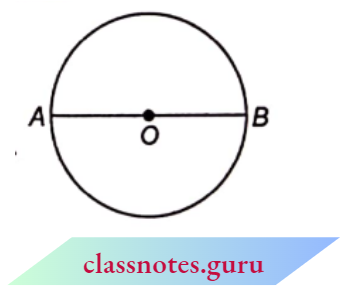
Coordinates of mid-point Q of AB
=\(\left(\frac{-2+2}{2}, \frac{2+8}{2}\right)=(0,5)\)
Coordinates of mid-point P of AQ
=\(\left(\frac{-2+0}{2}, \frac{2+5}{2}\right)=\left(-1, \frac{7}{2}\right)\)
Coordinates of mid-point R of QB
=\(\left(\frac{0+2}{2}, \frac{5+8}{2}\right)=\left(1, \frac{13}{2}\right)\)
Coordinates of the points dividing A and B into equal parts are
∴ \(\left(-1, \frac{7}{2}\right),(0,5),\left(1, \frac{13}{2}\right)\)
Question 10. Find the area of a rhombus in its vertices as (3, 0), (4, 5), (— 1, 4) and diagonals (-2.-1) taken in order. [Hint : Area of a rhombus \(\frac{1}{2}\)(product of its diagonals)]
Solution :
Given
(3, 0), (4, 5), (— 1, 4) and diagonals (-2.-1)
Let the vertices of a rhombus be in the following order :
A =(3,0), B=(4,5),
C =(-1,4), D=(-2,-1)
A C=\(\sqrt{(-1-3)^2+(4-0)^2}\)
= \(\sqrt{16+16}=\sqrt{32}=4 \sqrt{2}\) units
B D =\(\sqrt{(-2-4)^2+(-1-5)^2}\)
= \(\sqrt{36+36}=\sqrt{72}=6 \sqrt{2}\) units
Now, area of rhombus =\(\frac{1}{2} \times\) product of diagonals
= \(\frac{1}{2} \times A C \times B D\)
= \(\frac{1}{2} \times 4 \sqrt{2} \times 6 \sqrt{2}\)
=24 sq. units
The area of a rhombus =24 sq. units
Coordinate Geometry solved examples Class 10 CBSE
NCERT Exemplar Solutions for Class 10 Maths Chapter 7 Co-Ordinate Geometry Co-Ordinate Geometry Exercise 7.3
Question 1. Find the area of the triangle whose vertices are :
- (2, 3), (-1,0), (2,-4)
- (-5-1), (3,-5), (5, 2)
Solution :
(1) Vertices of the given triangle are
⇒ \(\left(x_1, y_1\right)=(2,3)\),
⇒ \(\left(x_2, y_2\right)=(-1,0)\),
⇒ \(\left(x_3, y_3\right)=(2,-4)\)
Area of triangle =\(\frac{1}{2}[(x_1 y_2+x_2 y_3+x_3 y_1)\)\(-(x_2 y_1+x_3 y_2+x_1 y_3)]\)
= \(\frac{1}{2}[\{2 \times 0+(-1) \times(-4)+2 \times 3\}\)-{(-1) \times 3+2 \times 0+2 \times(-4)\}][/latex]
= \(\frac{1}{2}[(0+4+6)-(-3+0-8)]\)
= \(\frac{1}{2}(10+11)=\frac{21}{2}\)
Area of triangle =\(\frac{21}{2}\) sq. units
(2) Vertices of triangle are
⇒ \(\left(x_1, y_1\right)=(-5,-1),\left(x_2, y_2\right)=(3,-5),\left(x_3, y_3\right)=(5,2)\)
=\(\frac{1}{2}[(x_1 y_2+x_2 y_3+x_3 y_1\) \(-(x_2 y_1+x_3 y_2+x_1 y_3)]\)
=\(\frac{1}{2}[\{(-5) \times(-5)+3 \times 2+5 \times(-1)\}-\{3 \times(-1)+5 \times(-5)+(-5) \times 2\}]\)
=\(\frac{1}{2}[(25+6-5)-(-3-25-10)]\)
=\(\frac{1}{2}(26+38)=32\)
Area of triangle =32 sq. units
Question 2. In each of the following find the value of ‘k’, for which the points are collinear.
- (7,-2), (5, 1), (3, k)
- (8,1),(k,-4),(2,-5)
Solution :
(1) Let the given points are as follows:
A=\(\left(x_1, y_1\right)=(7,-2), \quad B=\left(x_2, y_2\right)=(5,1)C=\left(x_3, y_3\right)=(3, k)\)
A, B and C are collinear.
Area of \(\triangle A B C\)=0
⇒ \(\frac{1}{2}[(x_1 y_2+x_2 y_3+x_3 y_1) – (x_2 y_1+x_3 y_2+x_1 y_3)]\)=0
⇒ \((x_1 y_2+x_2 y_3+x_3 y_1)\)
⇒ \(-(x_2 v_1+x_2 v_2+x_1 y_3)\) =0
⇒ \({7 \times 1+5 \times k+3 \times(-2)\}-\{5 \times(-2)+3 \times 1+7 \times k}\) =0
(7+5 k-6)-(-10+3+7 k) =0
(1+5 k)-(-7+7 k) =0
1+5 k+7-7 k =0
8-2 k=0 \(\Rightarrow k =4\)
(2) Let the given points are as follows:
A \(\equiv\left(x_1, y_1\right)=(8,1), B=\left(x_2, y_2\right)=(k,-4)\),
C=\(\left(x_3, y_3\right)=(2,-5)\)
A, B and C are collinear
Area of \(\triangle A B C\)=0
⇒ \(\frac{1}{2}[(x_1 y_2+x_2 y_3+x_3 y_1)\).
⇒ \(\left.-\left(x_2 y_1+x_3 y_2+x_1 y_3\right)\right]\)=0
⇒ \(\left(x_1 y_2+x_2 y_3+x_3 y_1\right)\)
– \(\left(x_2 y_1+x_3 y_2+x_1 y_3\right)\)=0
⇒ \({8 \times(-4)+k \times(-5)+2 \times 1}\)
⇒ \({k \times 1+2 \times(-4)+8 \times(-5)}\)=0
⇒ \((-32-5 k+2)-(k-8-40)\)=0
(-30-5 k)-(k-48)=0
-30-5 k-k+48=0
-6 k+18=0 \(\Rightarrow k=3\)
Question 3. Find the area of the triangle formed by joining the mid-points of the sides of the triangle whose vertices are (0, -1), (2, 1) and (0, 3). Find the ratio of this area to the area of the given triangle.
Solution :
Given
(0, -1), (2, 1) and (0, 3)
Let vertices of \(\triangle\)ABC are
A=\(\left(x_1, y_1\right)=(0,-1), B=\left(x_2, y_2\right)=(2,1)\)
and C=\(\left(x_3, y_3\right)=(0,3)\).
Area of \(\triangle A B C\)
= \(\frac{1}{2}[(x_1 y_2+x_2 y_3+x_3 y_1\)
⇒ \(\left.-\left(x_2 y_1+x_3 y_2+x_1 y_3\right)\right\}\)
=\(\frac{1}{2}[\{0 \times 1+2 \times 3+0 \times(-1)\}\)
⇒ \(-\{2 \times(-1)+0 \times 1+0 \times 3\}]\)
=\(\frac{1}{2}[(0+6+0)-(-2+0+0)]\)
=\(\frac{1}{2}(6+2)\)=4 sq. units
Coordinates of mid-point P of AB
= \(\left(\frac{0+2}{2}, \frac{-1+1}{2}\right)=(1,0)\)
Coordinates of mid-point Q of BC
=\(\left(\frac{2+0}{2}, \frac{1+3}{2}\right)=(1,2)\)
Coordinates of mid-point R of CA
=\(\left(\frac{0+0}{2}, \frac{3-1}{2}\right)=(0,1)\)
Area of \(\triangle P Q R\)
= \(\frac{1}{2}[(1 \times 2+1 \times 1+0 \times 0) -(1 \times 0+0 \times 2+1 \times 1)]\)
= \(\frac{1}{2}[(2+1+0)-(0+0+1)\)
= \(\frac{1}{2}(3-1)\)=1 sq. unit
Now,\(\frac{\text { area of } \triangle P Q R}{\text { area of } \triangle A B C}=\frac{1}{4}\)=1: 4
Question 4. Find the area of the quadrilateral whose vertices, taken in order, are (-4, -2), (-3, -5), (3,-2) and (2,3).
Solution:
Given
(-4, -2), (-3, -5), (3,-2) and (2,3)
Let the vertices of □ ABCD in order are as follows :
A=\(\left(x_1, y_1\right)=(-4,-2)\)
B=\(\left(x_2, y_2\right)=(-3,-5)\)
C=\(\left(x_3, y_3\right)=(3,-2)\)
D=\(\left(x_4, y_4\right)=(2,3)\)
Area of Square A B C D
= \(\frac{1}{2}\left[\left(x_1 y_2+x_2 y_3+x_3 y_4+x_4 y_1\right)\right.\)
–\((x_2 y_1+x_3 y_2+x_4 y_3+x_1 y_4)]\)
= \(\frac{1}{2}[\{(-4) \times(-5)+(-3) \times(-2)+3 \times 3 +2 \times(-2)\}-\{(-3) \times(-2)+3 \times(-5)\) +\(2 \times(-2)+(-4) \times 3\}]\)
= \(\frac{1}{2}[(20+6+9-4)-(6-15-4-12)]\)
= \(\frac{1}{2}(31+25)\)=28 sq. units
Question 5. The median of a triangle divides it into two triangles of equal areas. Verify this result for \(\triangle\)ABC whose vertices are A(4, -6), B(3, -2) and C(5, 2).
Solution:
Conlinates of mid-point D of BC’
=\(\left(\frac{3+5}{2}, \frac{-2+2}{2}\right)=(1,0)\)
Area of \(\triangle ABD\)
=\(|\begin{array}{c} \frac{1}{2}\,\{4 \times(-2)+3 \times(1)+4 \times(-6)\} -\{3 \times(-6)+4 \times(-2)+4 \times(0) \mid \end{array}\|\)
=\(\left|\frac{1}{2}\right|(-8+0-2.4)-(-18-8+(0)||\)
=\(\left|\frac{1}{2}(-32+20)\right|=|-3|\)=3 sq. units
Area of \(\triangle ACD\) е:
\( =\begin{array}{r}\frac{1}{2}, 1(4 \times 0+4 \times 2+5 \times(-6) \mid \\
-14 \times(-6)+5 \times 0+4 \times 2) \mid
\end{array}|\)
= \(|\frac{1}{2}(0+8-3(0)-(-24+0+8)|\)
=\( \frac{1}{2}(-22+|(0)|=|-3|\)=3sq. units
⇒ I\(\triangle ABD\)I= \(\triangle ACD\)
Therefore, the median AD divides it into two triangles of equal areas. Hence Proved.
NCERT Exemplar Solutions for Class 10 Maths Chapter 7 Co-Ordinate Geometry Co-Ordinate Geometry Exercise 7.4
Question 1. Determine the ratio in which the line 2x + y – 4 = 0 divides the line segment joining the points A(2, – 2) and B(3, 7).
Solution :
Let the line 2x + y – 4 =0 divides the line segment joining the points A (2, -2) and P (3, 7) in the ratio m: 1 and the coordinates of the point of division are (x,y).
x=\(\frac{m(3)+1(2)}{m+1}=\frac{3 m+2}{m+1}\)
and y=\(\frac{m(7)+1(-2)}{m+1}=\frac{7 m-2}{m+1}\)
Point (x, y), lies on the line 2 x+y-4=0
⇒ \(2\left(\frac{3 m+2}{m+1}\right)+\frac{7 m-2}{m+1}-4=0\)
6 m+4+7 m-2-4(m+1)=0
13 m+2-4 m-4=0
9 m=2 \(\quad \Rightarrow \quad m=\frac{2}{9}\)
Required ratio =2: 9
Question 2. Find a relation between x and y if the points (x, y), (1,2) and (7, 0) are collinear.
Solution :
Given
Points (x, y), (1,2) and (7, 0) are collinear.
Area of \(\Delta\)=0
⇒ \(\frac{1}{2}[\{x \cdot 2+1 \cdot 0+7 \cdot y\}\)
–\(\{1 \cdot y+7 \cdot 2+0 \cdot x\}]\)=0
(2 x+7 y)-(y+14)=0
2 x+7 y-y-14=0
x+3 y-7=0
which is the required relation between x and y.
Question 3. Find the centre of a circle passing through the points (6, -6), (3, -7) and (3, 3).
Solution :
Given
(6, -6), (3, -7) and (3, 3)
Let the points A(6, -6), B(3, -7) and C(3, 3) lie on the circumference of a circle whose centre is P(h,k)
P A=P B=P C (radii of the circle )
⇒ \(P A^2=P B^2=P C^2\)
Now, vP A^2=P B^2[/latex]
Now, \(P A^2=P B^2\)
⇒ \((h-6)^2+(k+6)^2 =(h-3)^2+(k+7)^2\)
⇒ \(h^2-12 h+36+k^2 +12 k+36\)
= \(h^2-6 h+9+k^2+14 k+49\)
-12 h+6 h+12 k-14 k+72-58=0
-6 h-2 k+14=0
3 h+k=7
and \(P B^2=P^{\prime} C^2\)
⇒ \((h-3)^2+(k+7)^2=(h-3)^2+(k-3)^2\)
⇒ \((k+7)^2=(k-3)^2\)
⇒ \(k^2+14 k+49=k^2-6 k+9\)
14 k+6 k=9-49
20 k=-40
k=-2
Put the value of k in equation (1),
3 h-2 =7
h =3
Coordinates Of the centre of the circle = (3,2)
Question 4. The two opposite vertices of a MJU.UV ;uv (-1, 2) aiui (3, 2). Find the coordinates of the other two vertices.
Solution :
Given
The two opposite vertices of a MJU.UV ;uv (-1, 2) aiui (3, 2).
Let two opposite vertices of square ABCD be A(-1,2) and C(3, 2) which are known.
Let the coordinates of vertex B be (h, k).
Now, AB = BC (sides of the square)
⇒\(A B^2=B C^2\)
⇒ \((h+1)^2+(k-2)^2=(h-3)^2+(k-2)^2\)
⇒ \((h+1)^2=(h-3)^2\)
⇒ \(h^2+2 h+1=h^2-6 h+9\)
2 h+6 h=9-
8 h=8
h=1
⇒ \(Again, \quad A B^2+B C^2=A C^2 \quad\left( \angle B=90^{\circ}\right)\)
⇒ \((h+1)^2+(k-2)^2+(h-3)^2+(k-2)^2\)
=\((3+1)^2+(2-2)^2\)
⇒ \((1+1)^2+k^2-4 k+4+(1-3)^2+k^2-4 k+4\)
=16+0
⇒ \(4+2 k^2-8 k+8+4=16\)
⇒ \(2 k^2-8 k=0 \quad \Rightarrow 2 k(k-4)=0\)
k=0 or k=4
Therefore, the remaining two vertices of the square = (1,0) or (1,4)
Question 5. The Class X students of a secondary school in Krishinagar have been allotted a rectangular plot of land for their gardening activity. Saplings of Gulmohar are planted on the boundary at a distance of 1m from each other. There is a triangular grassy lawn in the plot as shown in the figure. The students are to sow seeds of flowering plants on the remaining area of the plot.

- What will be the coordinates of the vertices of A BQR if C is the origin?
- Also, calculate the areas of the triangles in these cases. What do you observe?
Solution :
(1) If A is the origin, then
P = (4. 6), Q=(3, 2), R=(6, 5)
Area of \(\triangle P Q R\)
=\(\frac{1}{2}[(4.2+3.5+6.6)-(3.6+6.2+4.5)] \)
=\(\frac{1}{2}[(8+15+36)-(18+12+20)]\)
=\(\frac{1}{2}(59-50)=\frac{9}{2}\) sq. units
(2) If C is the origin, then
P =(-12,-2), Q=(-13,-6),
R =(-10,-3)
Area of \(\triangle P Q R\)
= \(\frac{1}{2}[\{(-12)(-6)+(-13)(-3)+(-10)(-2)\}\)
–\(\{(-13)(-2)+(-10)(-6)+(-12)(-3)\}]\)
= \(\frac{1}{2}[(72+39+20)-(26+60+36)]\)
= \(\frac{1}{2}(131-122)=\frac{9}{2}\) sq. units
Area Of the Triangle is both in some cases
Class 10 Maths Coordinate Geometry chapter MCQs and Answers
Question 6. The vertices of a \(\triangle A B C\) are A (4,6), B(I, 5) and C(7, 2). A line is drawn to intersect sides AB and AC at D and E respectively, such that \(\frac{A D}{A B}=\frac{A E}{A C}=\frac{1}{4}\).
Calculate the area of the \(\triangle A D E\) AB AC 4 and compare it with the area of \(\triangle A B C\).
Solution:
Given
The vertices of a \(\triangle A B C\) are A (4,6), B(I, 5) and C(7, 2). A line is drawn to intersect sides AB and AC at D and E respectively,
A=(4,6), B=(1,5), C=(7,2)
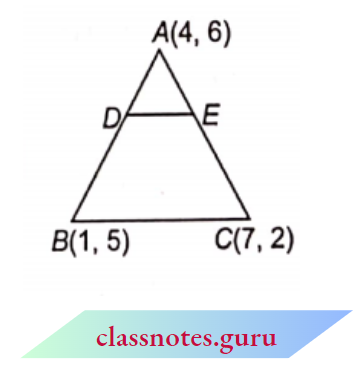
Area of \(\triangle A B C\)
= \(\frac{1}{2}[\{4.5+1.2+7.6\}\)
–\(\{1.6+7.5+4.2\}]\)
= \(\frac{1}{2}[(20+2+42) \quad \overbrace{B(1.5)}^{A(4,6)} -(6+35+8)] \)
= \(\frac{1}{2}(64-49)=\frac{15}{2}\) sq. units
Given, \(\quad \frac{A D}{A B}=\frac{1}{4} \quad \Rightarrow \quad \frac{A D}{A D+B D}=\frac{1}{4}\)
4 A D=A D+B D
3 A D=B D \(\quad \Rightarrow \quad \frac{A D}{B D}=\frac{1}{3}\)=1: 3
Point d divides B in the ratio 1 : 3. Therefore, the coordinates of point D
=\(\left(\frac{1 \times 1+3 \times 4}{1+3}, \frac{1 \times 5+3 \times 6}{1+3}\right)\)
=\(\left(\frac{1+12}{4}, \frac{5+18}{4}\right)=\left(\frac{13}{4}, \frac{23}{4}\right)\)
Again,\(\frac{A E}{A C} =\frac{1}{4} \quad \Rightarrow \quad \frac{A E}{A E+E C}=\frac{1}{4}\)
4 A E =A E+E C \(\Rightarrow 3 A E=E C\)
⇒ \(\frac{A E}{E C} =\frac{1}{3}=1: 3\)
Point E divides A-C in the ratio 1: 3. Therefore, the coordinates of point E
= \(\left(\frac{1 \times 7+3 \times 4}{1+3}, \frac{1 \times 2+3 \times 6}{1+3}\right)\)
= \(\left(\frac{7+12}{4}, \frac{2+18}{4}\right)=\left(\frac{19}{4}, 5\right)\)
Now, A = (4,6), D=\((\frac{13}{4}, \frac{23}{4}), E \equiv(\frac{19}{4}, 5\)
Area of \(\triangle A D E\)
= \(\frac{1}{2} {\left[\left\{4 \cdot \frac{23}{4}+\frac{13}{4} \cdot 5+\frac{19}{4} \cdot 6\right\}\right.}\)
–\({\frac{13}{4} \cdot 6+\frac{19}{4} \cdot \frac{23}{4}+4.5}]\)
=\(\frac{1}{2}[(23+\frac{65}{4}+\frac{114}{4})-(\frac{78}{4}+\frac{437}{16}+20)]\)
⇒ \(\frac{1}{2}\left[\frac{92+65+114}{4}-\frac{312+437+320}{16}\right] \)
= \(\frac{1}{2}\left[\frac{271}{4}-\frac{1069}{16}\right]=\frac{1}{2}\left(\frac{1084-1069}{16}\right)\)
= \(\frac{15}{32}\) square units
Now, \(\frac{\text { Area of } \triangle A D E}{\text { Area of } \triangle A B C}=\frac{15 / 32}{15 / 2}=\frac{1}{16}\)=1: 16
NCERT Exemplar Solutions for Class 10 Maths Chapter 7 Co-Ordinate Geometry Multiple Choice Questions
Question 1. The distance of the point (3,4) from the X-axis is :
- 3 units
- 4 units
- 5 units
- 1 unit
Answer:
Question 2. The distance of the point (8, -6) from the origin is :
- 10 units
- 6 units
- 8 units
- 14 units
Answer:
Question 3. The perimeter of a triangle with vertices (0, 0), (-3, 0) and (0, ‘1) is:
- 14 units
- 7 units
- 1 unit
- 12 Units
Answer:
Question 4. The points (-1. 0), (-1, 0) and (0, It) are the vertices of:
- a right-angled triangle
- an isosceles triangle
- an equilateral triangle
- a scalene triangle
Question 5. A(7, 0), B(4, 0) and C(S, 4) are the vertices of \(\triangle ABC\). The area of this triangle is :
- 14
- 28
- 8
- 6
Answer:
Question 6. (A-2, 3), B(6, 7) and C(8, 3) are three vertices of a parallelogram ABCD. The coordinates of vertex D are :
- (0,1)
- (0,-1)
- (c) (-1, 0)
- D(1,0)
Answer:
Question 7. The perpendicular bisector of the line segment joining the point (1,5) and (4, 6) intersects the Y-axis at point:
(0,13)
- (0,-13)
- (0, 12)
- (13, 0)
Answer:
Question 8. The mid-point of line segment joining the points A(-4, 2) and B( 5, 6) is \(P\left(\frac{a}{8}, 4\right)\). Then the value of A is
- -8
- -4
- 2
- 4
Question 9. The distance of the point (-3, 5) from the Y-axis is :
- -3
- 2
- 5
- None of these
Answer:
Question 10. The distance between two points (2, 3) and (4, 1) will be :
- 2
- 2 \(\sqrt{3}\)
- 2\( \sqrt{2}\)
- 3
Answer:
Question 11. The distance between the points P(2, -3) and (3(10, y) is 10 units. The value of y will be
- -3, 9
- -9, 3
- 9, 3
- -9, 2
Answer:
Class 10 Maths Coordinate Geometry chapter MCQs and Answers
Question 12. A point on X-axis, equidistant from the points A(2, -5) and 2, 9) will be :
- (-7, 0)
- (-6, 0)
- (-2, 0)
- (2, 0)
Question 13. The distance between the points (-1, -3) and (5, 2) is :
- \(\sqrt{61}\) units
- \(\sqrt{37} units\)
- \(\sqrt{17}\) units
- 3 units
Answer: \(\sqrt{61}\) units
